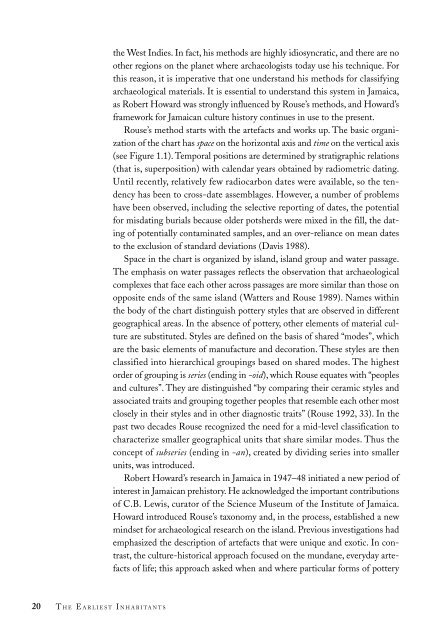The Earliest Inhabitants: The Dynamics of the Jamaican Taino
by Lesley-Gail Atkinson
by Lesley-Gail Atkinson
You also want an ePaper? Increase the reach of your titles
YUMPU automatically turns print PDFs into web optimized ePapers that Google loves.
20 T HE E ARLIEST I NHABITANTS<br />
<strong>the</strong> West Indies. In fact, his methods are highly idiosyncratic, and <strong>the</strong>re are no<br />
o<strong>the</strong>r regions on <strong>the</strong> planet where archaeologists today use his technique. For<br />
this reason, it is imperative that one understand his methods for classifying<br />
archaeological materials. It is essential to understand this system in Jamaica,<br />
as Robert Howard was strongly influenced by Rouse’s methods, and Howard’s<br />
framework for <strong>Jamaican</strong> culture history continues in use to <strong>the</strong> present.<br />
Rouse’s method starts with <strong>the</strong> artefacts and works up. <strong>The</strong> basic organization<br />
<strong>of</strong> <strong>the</strong> chart has space on <strong>the</strong> horizontal axis and time on <strong>the</strong> vertical axis<br />
(see Figure 1.1). Temporal positions are determined by stratigraphic relations<br />
(that is, superposition) with calendar years obtained by radiometric dating.<br />
Until recently, relatively few radiocarbon dates were available, so <strong>the</strong> tendency<br />
has been to cross-date assemblages. However, a number <strong>of</strong> problems<br />
have been observed, including <strong>the</strong> selective reporting <strong>of</strong> dates, <strong>the</strong> potential<br />
for misdating burials because older potsherds were mixed in <strong>the</strong> fill, <strong>the</strong> dating<br />
<strong>of</strong> potentially contaminated samples, and an over-reliance on mean dates<br />
to <strong>the</strong> exclusion <strong>of</strong> standard deviations (Davis 1988).<br />
Space in <strong>the</strong> chart is organized by island, island group and water passage.<br />
<strong>The</strong> emphasis on water passages reflects <strong>the</strong> observation that archaeological<br />
complexes that face each o<strong>the</strong>r across passages are more similar than those on<br />
opposite ends <strong>of</strong> <strong>the</strong> same island (Watters and Rouse 1989). Names within<br />
<strong>the</strong> body <strong>of</strong> <strong>the</strong> chart distinguish pottery styles that are observed in different<br />
geographical areas. In <strong>the</strong> absence <strong>of</strong> pottery, o<strong>the</strong>r elements <strong>of</strong> material culture<br />
are substituted. Styles are defined on <strong>the</strong> basis <strong>of</strong> shared “modes”, which<br />
are <strong>the</strong> basic elements <strong>of</strong> manufacture and decoration. <strong>The</strong>se styles are <strong>the</strong>n<br />
classified into hierarchical groupings based on shared modes. <strong>The</strong> highest<br />
order <strong>of</strong> grouping is series (ending in -oid), which Rouse equates with “peoples<br />
and cultures”. <strong>The</strong>y are distinguished “by comparing <strong>the</strong>ir ceramic styles and<br />
associated traits and grouping toge<strong>the</strong>r peoples that resemble each o<strong>the</strong>r most<br />
closely in <strong>the</strong>ir styles and in o<strong>the</strong>r diagnostic traits” (Rouse 1992, 33). In <strong>the</strong><br />
past two decades Rouse recognized <strong>the</strong> need for a mid-level classification to<br />
characterize smaller geographical units that share similar modes. Thus <strong>the</strong><br />
concept <strong>of</strong> subseries (ending in -an), created by dividing series into smaller<br />
units, was introduced.<br />
Robert Howard’s research in Jamaica in 1947–48 initiated a new period <strong>of</strong><br />
interest in <strong>Jamaican</strong> prehistory. He acknowledged <strong>the</strong> important contributions<br />
<strong>of</strong> C.B. Lewis, curator <strong>of</strong> <strong>the</strong> Science Museum <strong>of</strong> <strong>the</strong> Institute <strong>of</strong> Jamaica.<br />
Howard introduced Rouse’s taxonomy and, in <strong>the</strong> process, established a new<br />
mindset for archaeological research on <strong>the</strong> island. Previous investigations had<br />
emphasized <strong>the</strong> description <strong>of</strong> artefacts that were unique and exotic. In contrast,<br />
<strong>the</strong> culture-historical approach focused on <strong>the</strong> mundane, everyday artefacts<br />
<strong>of</strong> life; this approach asked when and where particular forms <strong>of</strong> pottery


















